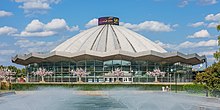Jakow Borissowitsch Belopolski
Yakov Borisovich Belopolski ( Russian Яков Борисович Белопольский * April 23 . Jul / 6. May 1916 greg. In Kiev , † 5. May 1993 in Moscow ) was a Soviet architect .
Life

Belopolski studied at the Moscow Architecture Institute (MArchI) from 1932 to 1937. From 1938 he was involved in the planning of the Palace of the Soviets in the design of the interior of the hall for government receptions and the design of the square in front of the palace. He helped design the entrance hall of the Soviet Union Pavilion at the 1939 New York World's Fair . At the same time he successfully participated in competitions for monument projects for the 26 commissioners of Baku , the heroes of Perekop and Kosta Chetagurov . In 1943 he became a member of the Communist Party .
After the Second World War , Belopolski and Boris M. Iofan developed a project for the design of the center of Novorossiysk . He took part in the reconstruction and expansion of Moscow, especially in the southwestern administrative district (1952–1966). He was involved in the library of the Academy of Sciences of the USSR (AN-SSSR) and the Academy of Medical Sciences of the USSR, at the Russian Patrice Lumumba University of Friendship of Peoples , at the Institute of Scientific Informatics for Social Sciences of the AN-SSSR (INION ) (with JP Wulych and LW Missoschnikow ) and at the Great Moscow State Circus (with JP Wulych, 1971).
Belopolski was involved as an architect in the memorials for the liberation fighter in Treptower Park in Berlin (1946-1949), the mother home on Mamayev Hill in Volgograd (1967) and the workers behind the front in Magnitogorsk (1979). This triptych memorial symbolizes the sword that was forged in Magnitogorsk, raised in Stalingrad and laid down in Berlin after the victory.
In 1983 Belopolski became a member of the Academy of Fine Arts of the USSR .
Belopolski was buried in Moscow's Donskoy cemetery .
Honors, prizes
- Medal "For heroic work in the Great Patriotic War 1941–1945"
- Stalin Prize (1950) for the architectural project for the monument in Treptower Park in Berlin
- Badge of Honor of the Soviet Union (1963)
- Honored Architect of the RSFSR (1966)
- Order of Lenin (1967)
- Lenin Prize (1970) for the architectural project for the monument on Mamayev Hill in Volgograd
- People's Architect of the USSR (1988)
- State Prize of the Russian Federation
Individual evidence
- ↑ a b c Есаулов Г. В., Кананин Р. Г .: Яков Борисович Белопольский . In: Архитектура и строительство Москвы . No. 5 , 2006.
- ↑ Есаулов Г.В .: Яков Белопольский - Yakov Belopolsky . Из-во Улей, Moscow 2009.
- ↑ Russian Wikipedia, article Hinterland und Front, ru: Тыл - фронту (монумент)
- ↑ Ильин С. Б., Лонгинов А. С., Сульдин А. В .: Всенародная академия . Издательство политической литературы, Moscow 1986, p. 62 .
- ↑ Кудзоев О. А .: Скульптурная летопись края . 1989, p. 101 .
- ↑ Слука И .: Великая Отечественная война . In: 100 самых знаменитых монет СССР . 2015, p. 17 .
- ↑ Монумент скульптура Родина-мать в Волгограде (accessed September 28, 2017).
| personal data | |
|---|---|
| SURNAME | Belopolski, Jakow Borissowitsch |
| ALTERNATIVE NAMES | Белопольский, Яков Борисович (Russian) |
| BRIEF DESCRIPTION | soviet architect |
| DATE OF BIRTH | May 6, 1916 |
| PLACE OF BIRTH | Kiev |
| DATE OF DEATH | May 5, 1993 |
| Place of death | Moscow |

